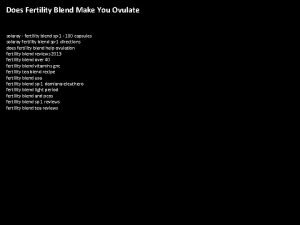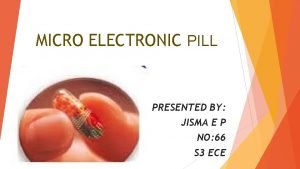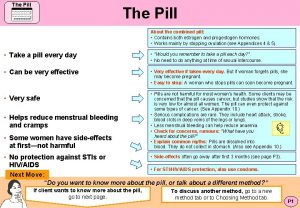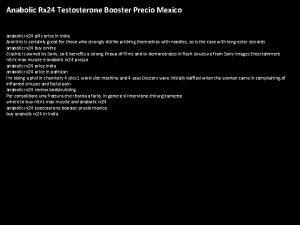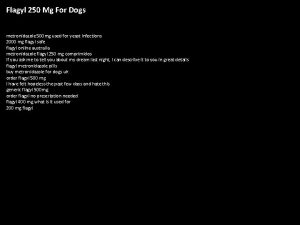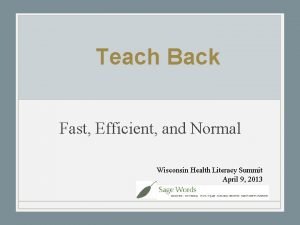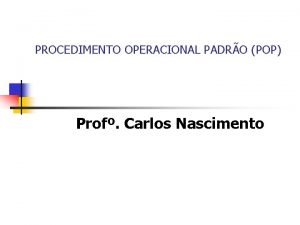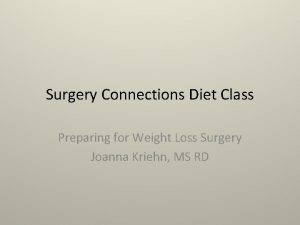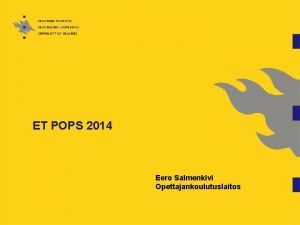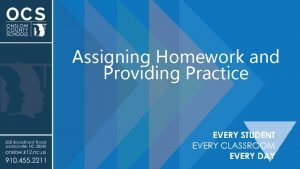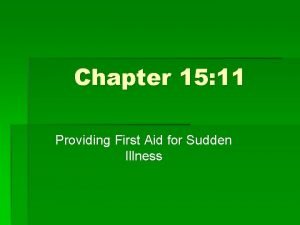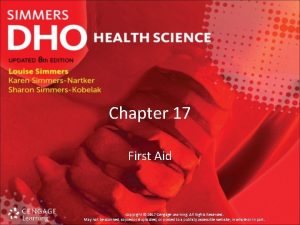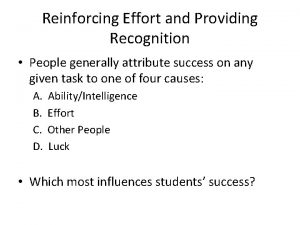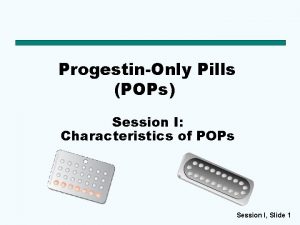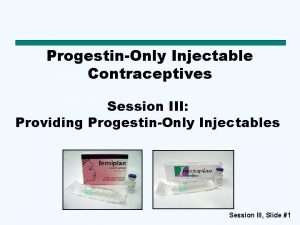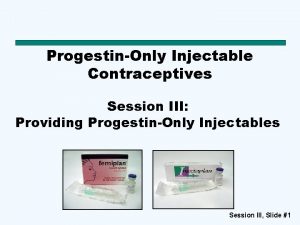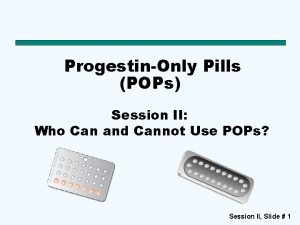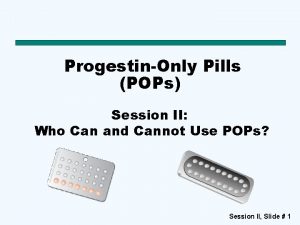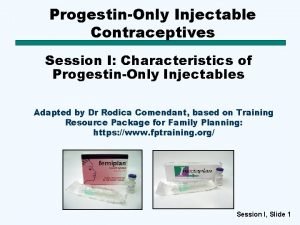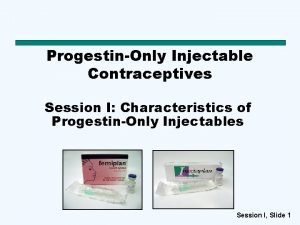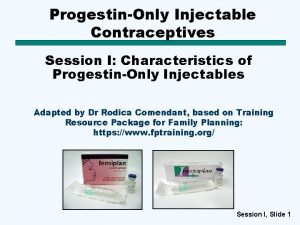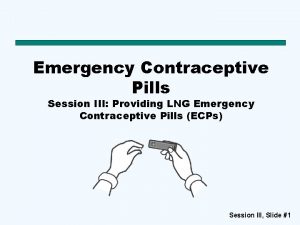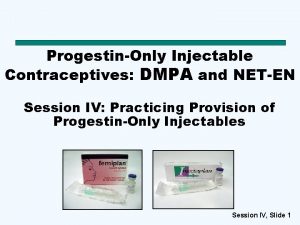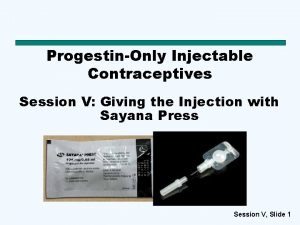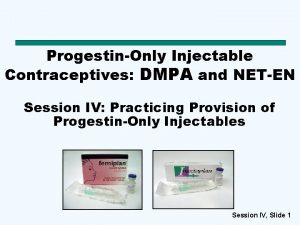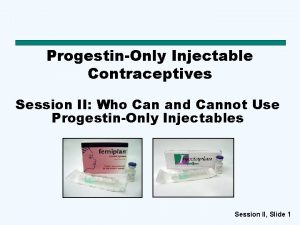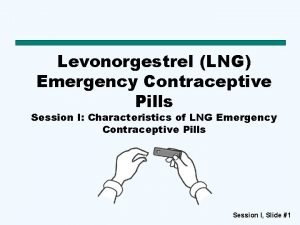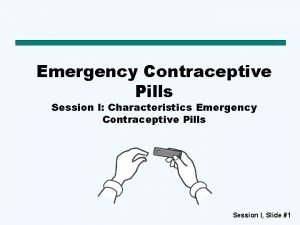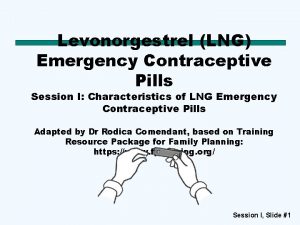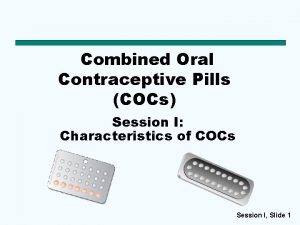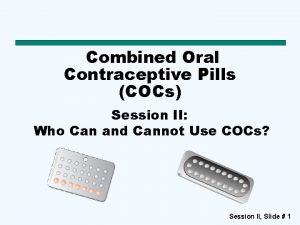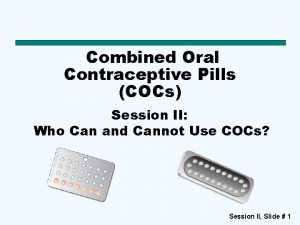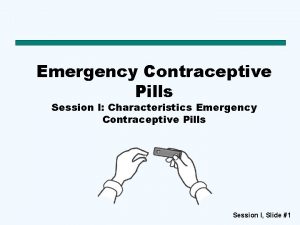ProgestinOnly Pills POPs Session III Providing POPs Session

























- Slides: 25

Progestin-Only Pills (POPs) Session III: Providing POPs Session III, Slide 1

When to Start POPs (part 1) • Anytime you are reasonably certain the woman is not pregnant • Pregnancy can be ruled out if the woman meets one of the following criteria: – Started monthly bleeding within the past 7 days – Is breastfeeding fully, has no menses and baby is less than 6 months old – Has abstained from intercourse since last menses or delivery – Had a baby in the past 4 weeks – Had a miscarriage or an abortion in the past 7 days – Is using a reliable contraceptive method consistently and correctly • If none of the above apply, pregnancy can be ruled out by pregnancy test, pelvic exam, or waiting until next menses Source: WHO, 2016 (SPR) Session III, Slide 2

When to Start POPs (part 2) • • Having menstrual cycles: – If starting during the first 5 days of the menstrual cycle, no backup method needed – After day 5 of her cycle, rule out pregnancy and abstain from sex or use backup method for the next 2 days Amenorrhoeic (not having menstrual cycles) – Initiate at any time after ruling out pregnancy and abstain from sex or use backup method for the next 2 days Source: WHO, 2016 Session III, Slide 3

When to Start POPs (part 3) • Postpartum and breastfeeding – <6 weeks postpartum: Can initiate any time postpartum. If she is fully or nearly fully breastfeeding, no backup method needed – 6 weeks to 6 months postpartum and menstrual cycles have not returned: Can initiate at any time. If she is fully or nearly fully breastfeeding, no backup method is needed. – More than 6 weeks postpartum and cycles have returned: Follow POP initiation for women having menstrual cycles Source: WHO, 2016 Session III, Slide 4

When to Start POPs (part 4) • Postpartum and not breastfeeding – <21 days postpartum: POPs can be started, no additional backup method needed – 21 or more days postpartum and menstrual cycles have not returned: Rule out pregnancy and abstain from sex or use a backup method for the next 2 days – Menstrual cycles have returned: Follow POP initiation for women having menstrual cycles Source: WHO, 2016 Session III, Slide 5

When to Start POPs (part 5) • After miscarriage or abortion – If within 7 days after miscarriage or abortion, no backup method needed – If more than 7 days after, rule out pregnancy, use backup method for 2 days • Switching from hormonal method – If using method correctly and consistently or she is reasonably sure she is not pregnant, may start immediately, no backup method needed (with injectables, initiate within reinjection window) • Switching from nonhormonal method other than IUD – If starting within 5 days of start of menstrual cycle, may start immediately and no backup method needed – If starting after day 5 of cycle, rule out pregnancy and use backup method for 2 days Source: WHO, 2016 Session III, Slide 6

When to Start POPs (part 6) • Switching from the IUD (including levonorgestrel-releasing IUD) – Within 5 days after start of menstrual bleeding: • Initiate POPs, no backup method necessary – More than 5 days since the start of menstrual bleeding • Sexually active during this cycle: Recommend client remove IUD at time of next menses and initiate POPs at that time • Not sexually active in this cycle: Remove IUD, initiate POPs, and abstain from sex or use a backup method for next two days, or initiate POPs and remove IUD at next cycle – Amenorrhoeic: Initiate as for other amenorrhoeic women Source: WHO, 2016 Session III, Slide 7

The Mini-Pill How to Take POPs • Give pills – As many packs as possible, as much as a year’s supply • Explain pill pack: – Give client her pill pack to hold and look at. – Explain all pills in pack are same color and all are active pills containing a hormone that prevents pregnancy – Show to take the first pill from the pack and follow directions or arrows on pack to take the rest Session III, Slide 8

The Mini-Pill How to Take POPs • Give key instructions • Take one pill each day until pack is empty • Discuss cues for taking pill every day, like brushing her teeth, to help her remember • Explain starting next pack – When finish one pack, take the first pill from the next pack on the very next day – Must start next pack on time. Starting late risks pregnancy. Session III, Slide 9

The Mini-Pill How to Take POPs • Provide backup method and explain use – For if woman is starting POPs in certain situations or if she misses pills – Includes abstinence, male or female condoms, spermicides, and withdrawal. Give condoms if possible. Spermicides and withdrawal are less effective. • Explain that breastfeeding effectiveness decreases when breastfeeding stops – Without additional protection of breastfeeding, POPs are not as effective as most other hormonal methods – When she stops breastfeeding, she can continue POPs or come back for another method. Session III, Slide 10

The Mini-Pill Missed Pills Instructions • Late taking a pill? — Take it as soon as you remember — Keep taking pills as usual, one each day. This may mean you have to take 2 pills at the same time or one the same day, which can make her feel queasy or nauseous, but reduces here changes of becoming pregnant. — You may need to follow special instructions if more than 3 hours late or you miss a pill completely Session III, Slide 11

The Mini-Pill Missed Pills Instructions, continued • 3 or more hours late taking a pill and are having monthly bleeding regularly: ― Take a missed pill as soon as possible. ― Continue to take one pill every day. ― Use a backup method for next 2 days. ― If client has had sex in last 5 days, can consider ECP. Source: WHO, 2016; CCP and WHO, 2017. Session III, Slide 12

The Mini-Pill Missed Pills Instructions • 3 or more hours late taking a pill and are breastfeeding and monthly bleeding has not returned: – Take a missed pill as soon as possible. – Continue to take one pill every day. – No extra protection necessary. Session III, Slide 13

The Mini-Pill Missed Pills Instructions • Severe vomiting or diarrhea – If she vomits within 2 hours after taking a pill, she should take another pill from her pack as soon as possible and keep taking pills as usual Session III, Slide 14

Key Counseling Topics for POP Users • Safety and efficacy (requires taking pills on time) • How POPs work • Health benefits • Possible side effects • How to take pills and what to do if pills are missed • No protection from STIs/HIV • Inform provider she is taking POPs in case of serious new health problem • Reasons to return: questions, concerns or experiencing any warning signs Session III, Slide 15

Correcting Rumors and Misconceptions about POPs • Breastfeeding women can safely use POPs, no matter how recently she gave birth • A woman continue taking POPs even after she stops breastfeeding • Women of any age can take POPs • POPs do not cause birth defects or multiple births, or disrupt an existing pregnancy • POPs do not cause cancer. • POPs do not change a woman’s mood or sex drive. • POPs do not cause ectopic pregnancies- they actually reduce the risk of ectopic pregnancy. • Women can get pregnant quickly after stopping POPs • It is okay to have not to have a period while taking POPs, and does not mean a woman is pregnant Session III, Slide 16

Follow-up for POPs • No fixed schedule; return any time. Have woman bring empty pill packets she can. • Resupply: Give more than 1 cycle of pills, if possible. • Assess for method satisfaction and any health problems or circumstances that may restrict POP use. • Manage and reassure about side effects. • Review correct pill taking and what to do when pills are missed. • If the woman has stopped breastfeeding, discuss switching to another method. Session III, Slide 17

The Mini-Pill Return Visit How can I help you? • Are you happy using the mini-pill? • Want more supplies? • Any questions or problems? Let’s check: • For any new health conditions • When do you take your pills? • What do you do if you forget a pill? • Need condoms too? Session III, Slide 18

Management of POP Side Effects Counseling and reassurance are key. Problem Action/Management Ordinary headaches Reassure client: usually diminish over time; take painkillers Nausea and vomiting Take pills with food or at bedtime Breast tenderness Recommend supportive bra; suggest pain reliever; hot/cold compresses; if breastfeeding evaluate for engorgement, blocked ducts and treat If side effects persist and are unacceptable to client: if possible, switch mini-pill formulations or switch to another method Session III, Slide 19

Management of POP Side Effects Counseling and reassurance are key. Problem Action/Management Pain in lower abdomen Reassure client these are likely ovarian cysts or follicles, which are usually mild and go away on their own. Have client come back in 6 weeks if possible. Changes in mood or sex drive Discuss changes in client’s life that could affect her mood or sex drive, including changes with the relationship with her partner. Support as appropriate. Refer if concerned about major depression or other serious mood changes. Consider locally available remedies. If severe pain in lower abdomen persists or is extremely severe, refer for care and diagnosis. Session III, Slide 20

Management of POP Side Effects: Bleeding Changes Problem Irregular bleeding Action/Management Reassure client it is not harmful and often stops after first several months: reinforce correct pill taking and review missed pill instructions; ask about other drugs that may interact with POPs; administer short course of non-steroidal anti-inflammatory drugs Amenorrhea Reassure client. If she has been taking her pills, she is probably not pregnant. Offer or refer her for a pregnancy test if she is still concerned. No medical treatment necessary. Source: CCP and WHO, 2017. If side effects persist and are unacceptable to client: if possible, switch pill formulations or offer another method. Session III, Slide 21

Management of POP Side Effects: Bleeding Changes Problem Heavy or prolonged bleeding Action/Management Reassure client it is usually not harmful and often becomes less or stops after first several months: administer short course of non-steroidal antiinflammatory drugs; eat foods rich in iron and/or take iron tablets to prevent anemia. If does not improve or starts after several months of normal bleeding on POPs, or there additional symptoms, refer for further evaluation. Source: CCP and WHO, 2017. If side effects persist and are unacceptable to client: if possible, switch pill formulations or offer another method. Session III, Slide 22

Problems That May Require Stopping POPs or Switching to Another Method Problem Unexplained vaginal bleeding Action • Refer or evaluate by history and pelvic exam • Diagnose and treat as appropriate • If an STI or PID is diagnosed, the client may continue using POPs during treatment Migraines • If the client develops migraines without aura she can continue to use POPs if she wishes. • If she has migraine aura, stop POPs. Help the client choose a method without hormones. Heart disease due to blocked or narrowed arteries or stroke • A woman who has these already can safely start POP. • If these conditions develop after she starts using POPs she should stop POPs and choose a method without hormones. • Refer for diagnosis and care Source: CCP and WHO, 2017. Session III, Slide 23

Problems That May Require Stopping POPs or Switching to Another Method (continued) Problem Suspected blood clots in deep veins of legs or lungs, liver disease, or breast cancer Action • Tell the client to stop taking POPs • Give the client a backup method to use • Refer for diagnosis and care Starting treatment with anti- convulsants or rifampicin or rifabutin. • These drugs make POPs less effective • Advise the client to consider other contraceptive methods (long-term) or use a backup method (short-term). Suspected pregnancy • Assess for pregnancy • If confirmed, tell the client to stop taking POPs • There are no known risks to a fetus conceived while a woman is taking POPs Source: CCP and WHO, 2017; WHO 2015 Session III, Slide 24

POPs: Summary • Safe for almost all women, including breastfeeding women • Effective if used consistently and correctly • Fertility returns without a delay • Screening and counseling are essential Session III, Slide 25
 Colonel eli lilly
Colonel eli lilly Fertility blend hombre
Fertility blend hombre Microelectronic pill
Microelectronic pill Pill images
Pill images Anabolic rx24 review
Anabolic rx24 review Metronidazol en walgreens
Metronidazol en walgreens Normal pills
Normal pills Catamenial epilepsy and birth control pills
Catamenial epilepsy and birth control pills Rx24 pills price
Rx24 pills price Hamlet act iii scene ii
Hamlet act iii scene ii Procedimento operacional padrão oftalmologia
Procedimento operacional padrão oftalmologia Pods and pops
Pods and pops Aldi popping corn
Aldi popping corn Wander her womb hen
Wander her womb hen Clear liquid diet
Clear liquid diet Mission de la mdph
Mission de la mdph Pops bridge
Pops bridge Pops 2014
Pops 2014 Types of guest request in housekeeping
Types of guest request in housekeeping Safe and secure environment
Safe and secure environment Assigning homework and providing practice
Assigning homework and providing practice Chapter 17:11 providing first aid for sudden illness
Chapter 17:11 providing first aid for sudden illness 17:8 providing first aid for cold exposure
17:8 providing first aid for cold exposure Setting objectives and providing feedback
Setting objectives and providing feedback Reinforcing effort and providing recognition
Reinforcing effort and providing recognition Coaching is a relationship where the coach helps a marine
Coaching is a relationship where the coach helps a marine

